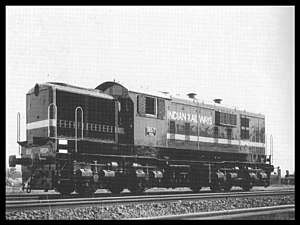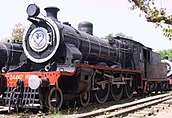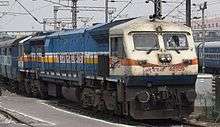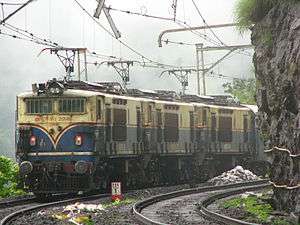Indian locomotive class WDM-3
The Indian locomotive class WDM-3 is a class of Diesel–hydraulic locomotive that was developed in 1962 by Henschel for Indian Railways. The model name stands for broad gauge (W), Diesel (D), Mixed traffic (M) engine, 3rd generation (3). They entered service in 1970. A total of 8 WDM-3 was built at between 1962 and 1998. They were decommissioned at gooty in 1995.
| Indian locomotive class WDM-3 | |||||||||||||||||||||||||||||||||||||||||||||||||||||||||||||||||||||||
|---|---|---|---|---|---|---|---|---|---|---|---|---|---|---|---|---|---|---|---|---|---|---|---|---|---|---|---|---|---|---|---|---|---|---|---|---|---|---|---|---|---|---|---|---|---|---|---|---|---|---|---|---|---|---|---|---|---|---|---|---|---|---|---|---|---|---|---|---|---|---|---|
 A WDM-3 idling | |||||||||||||||||||||||||||||||||||||||||||||||||||||||||||||||||||||||
| |||||||||||||||||||||||||||||||||||||||||||||||||||||||||||||||||||||||
| |||||||||||||||||||||||||||||||||||||||||||||||||||||||||||||||||||||||
| |||||||||||||||||||||||||||||||||||||||||||||||||||||||||||||||||||||||
| |||||||||||||||||||||||||||||||||||||||||||||||||||||||||||||||||||||||
These Diesel–hydraulic locomotives are not related to the ALCO WDM-3A. All are now retired from service
History
Introduction
A Mechanical Engineer of the Indian Railways developed a new hydro-mechanical transmission for diesel locomotives. The design was examined by the National Research and Development Corporation and was patented in India (as Suri transmission) sometime in 1956–57. In 1962, the Railway Board thought of developing Suri transmission in high horse-power locomotives in order to use its maximum benefit. For this purpose the Railway board, in April 1962, authorized to conduct negotiations with West German firms for 5000 horse-power locomotives and with ALCO for 2600 horse-power locomotives already under manufacture at Diesel Locomotive Works, Varanasi.
Selection of locomotives
Between 1962 and 1964, the Railway Board considered the question of procurement and development of Suri transmission in 5000 horse-power Locomotive or alternatively 2500 or 2600 horse-power locomotive. Having regard to the then technical assessment that the maximum benefits of Suri transmission were likely to show up in the higher horse-power range due to better power/weight ratio, the Board considered it desirable to procure a few 5000 horse-power locomotives with Suri/Mekydro transmission provided the prices were found to be reasonable and adequate guarantees on the performance of these locomotives engines and transmission systems were forthcoming.[1]
The Railway Board, in September 1964 issued tender inquiries to three West German firms. In response, offers were received from two firms who offered locomotives of 5000 horse-power with two 2500 horse-power Maybach engines. In June 1965, the Railway Board appointed a Technical Committee to examine these offers. The Committee was specifically asked to determine
- Technical suitability of the 5000 horsepower locomotives for the development of Suri transmission.
- in view of the difficulties experienced by American Railroads with 16 cylinder high speed Maybach engines, what precautions should be taken to ensure that 20 cylinder high speed Maybach engines (which were proposed to be fitted in the 5000 horse-power locomotives) gave minimum trouble under Indian conditions of working.
The Technical Committee on various considerations came to the conclusion (December 1965) that no economic benefits of capital and maintenance costs could be expected of 5000 horse-power locomotives as compared to those of dual coupled 2600 WDM-2. The Committee also stated that 5000 horsepower locomotives could not be adopted as a standard unit taking into account the restrictions imposed by track and bridge conditions, hauling capacity of the locomotives, impracticability of multiple operation and flexibility.[2]
Production
West German locomotive manufacturer soliciting their offer by 15th September 1966 which was extended up-to 28th September 1966. Both the firms submitted their offers. The Tender Committee found the offer of Henschel superior from technical as well as financial point of view and accordingly recommended its acceptance. The Research, Designs and Standards Organization of the Rail- ways (K.D.S.O.) also, after technical scrutiny, found the offer of firm B unacceptable. The Committee found that the guarantee terms offered by Henschel were more comprehensive than these of firm B. Henschel quoted for locomotives fitted with Suri transmission as well as Mekydro transmission.
The slightly higher price (DM 67,500 per locomotive) quoted for the locomotive fitted with Suri transmission over that fitted with Mekydro transmission was found more than justified considering the developmental expenses involved and the expected savings in fuel due to higher efficiency of Suri transmission. The Committee stated that Suri transmission;n would provide an efficiency of 92 per cent in the final stage as against a maximum efficiency of about 80-83 per cent in the Mekydro transmission and this higher efficiency should result in corresponding saving in fuel. On the assumption that a locomotive earned (ran) about 400 km per day on line and that fuel is consumed rate the rate of 4 liters per km therefor, the Committee assessed, on a rough basis, the annual saving at about Rs. 20,000 per locomotive even at 5 per cent higher efficiency.
Accordingly, the Committee recommended placement of order for 6 locomotives fitted with Suri transmission and 2 locomotives with Mekydro transmission on Henschel. The estimated f.o.b., value of the locomotives was about 10.4 DM ( value 11.02 million DM- approximately Rs. 2.08 crores). The Railway Board approved of these recommendations. Advance letter of acceptance of tender of Henschel was issued in December 1966.
The contract for the supply of the locomotives was evacuated with the firm on 23rd June, 1967. The firm had given a guarantee that the locomotive would be built fully in accordance with the specifications would operate properly. It also guaranteed proper functioning of Suri transmission. The guarantee was to last for a period of 24 months from the dates of commissioning of the locomotives in India or 26 months from the dates of shipment from Germany or 3.00,000 km run by each locomotive, whichever event should first occur. .
Performance of locomotives
The eight locomotives (WDM-3) arrived in India in the second half of 1970 and were commissioned between August 1970 and May 1971 at Gooty in Southern Railway. The expenditure booked up to August 1975 towards the cost of these locomotives was Rs. 3.37 crores. These locomotives were utilized mainly on freight services on the Guntakal Division of Southern Railway till November 1972, when they were introduced on express (passenger) service also.
In July 1971, Southern Railway Administration reported to the Railway Board that the locomotion had developed defects in the transmission system and convertor turbine wheels leading to failures. On the recommendations of the manufacturers certain modifications were carried out in torque convertor, turbine blades and mechanical clutches and thus the trouble in the system was overcome. Nevertheless, the performance of these locomotives had not been satisfactory in the extent of ineffectiveness of each Locomotive ranged from 15.5 percent to 45.3 percent (average 27.09 per cent) during the period from the dates of commissioning to end of April 1973. I11 April 1973, the Board called for a detailed report on the performance of these locomotives.
- The locomotive availability in tern of hours per day per locomotive in use was less for WDM-3 locomotives as compared to WDM-2 locomotives (manufactured in the country) as indicated in the table below
- On account of lower horse-power (less than 2600 horsepower), lower axle load (76 tonnes against 110 tonnes of WDM-2 1- motives) and lower convertor efficiency at low speeds, the WDM-3 locomotives hauled smaller loads, 23 per cent less in the up direction and 25 per cent less in the down direction, than WDM-2 locomotives particularly on st8 gradients ;
- The maintenance costs were more in case of WDM-3 locomotives (Rs. 6,851 for cylinder heads) as compared to WDM-2 locomotives (Rs. 2,632 for cylinder heads) ;
- The locomotive failure rate was higher in WDM-3 locomotives (43,379 km. per failure on the average during 1971-72 to 1974-75 ) when compared to WDM-2 locomotives (being 1.12,893 km. per failure in the same period) ;
- The fuel consumption of WDM-3 locomotives (both Suri and Mekydro transmissions) was approximately 20 per cent more than that of WDM-2 locomotives ; (a representative of the manufacturer had stated on 31st January 1973 that the Maybach high speed engine fitted on WDM-3 locomotives was likely to consume 10 per cent more fuel than WDM-2 engine on account of pre-combustion chamber configuration)
The various major defects in these locomotives transmissions and engines were brought to the notice of the manufacturers from time to time. The manufacturers advised the Railway Board in November 1973 that, as there had been engine damages on the locomotives equipped with Suri trans- mission, it would be necessary to operate: these transmissions purely hydraulically. The Railway Board agreed to the modifications being carried out. 'The modifications in essence meant, dumping Suri transmission and converting into simple hydraulic Mekydro transmission. This modification in all the locomotives fitted with Suri transmission Has carried out in December 1973- January 1974.
Comparison has sought to be made in the Southern Railway Report of fuel consumption figures between the WDM2 and WDM3 locos on the basis of liters per thousand gross tonne Kms. This index is only valid when the trailing loads are substantially similar. With the largely dissimilar trailing loads of WDM2 and WDM3 on this highly graded section, the per thousand KM fuel consumption basis would not be relevant.
However, when the two locomotives did haul similar loads, as in the case of Vrindavan Express between Madras and Bangalore, where the speeds attained were higher, the WDM3 locos showed 4 per cent lower fuel consumption that the WDM2 locomotives. The use of the WDM3 locos on Passenger trains could not be continued because of the specific project under which they had been procured which limited their use for freight traffic. Later, when permission for use on Passenger services was obtained from KFW, the reliability of the locos had already been impaired on account of non-availability of imported spares.
By 1990 these locomotives were withdrawn from service.
Former shed
- Gooty (GY): All the locomotives of this class has been withdrawn from service.
See also
References
Notes
- "[IRFCA] Indian Railways FAQ: Locomotives -- Specific classes : AC Electric". www.irfca.org. Retrieved 29 May 2020.
- "[IRFCA] Indian Railways FAQ: Diesel and Electric Locomotive Specifications". www.irfca.org. Retrieved 29 May 2020.
Bibliography
- Hughes, Hugh (1996). Indian Locomotives: Part 4 – 1941–1990. Harrow, Middlesex: The Continental Railway Circle. ISBN 0-9521655-1-1.



